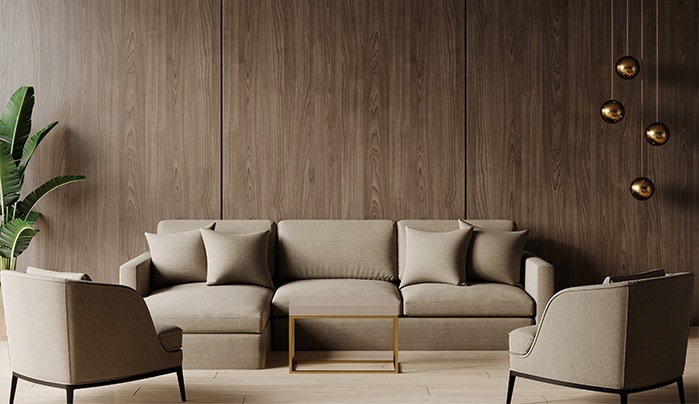Renovating your house can be an enduring and baffling task. Decorating veneers have come to the rescue and have gained immense popularity in recent years in the renovation and wood industry. Whether applied to wall panelling, furniture, or cabinets, decorative veneers offer a multitude of chances to transform ordinary surfaces into magnificent pieces of art. These little bits of real or artificial wood serve purposes beyond simply adding a stunning, luxurious appearance to a space and also provide practical advantages like durability, flexibility, and ease of installation.
Finding the right veneer for your house can be quite a complicated procedure, as there are multiple factors to keep in mind.

The Forest Stewardship Council (FSC) proposes that veneer makes better use of raw materials because a single tree can yield hundreds of square meters of wood surface.
Veneers are indeed the most authentic form of wood material in the market. They are prepared from premium quality wood like pine, cedar, walnut, maple, oak, and many others. They are soaked in water for longer tenures and thus can be later sliced into thin pieces using sharp angled slicers. They are created by bonding together thinly cut tree layers, as opposed to solid wood, which is sawn from a log.
The qualities that help it top over solid wood are:
Veneers are sourced from various species of wood, each with its own unique colour tone, designs, patterns, and finishings.
Here are a few points to ponder as you embark on a journey to upgrade the appeal of your interiors:
You are encouraged to consider the tree's origin or source before purchasing it and ensure the source is a responsible forest (certified FSC). This will help you to get a better grasp of the quality of the veneer. Wood species, including Beech, Wenge, Koto, Mahogany, Teak, Ash, Eucalyptus, Magano, Mapa, Jacoba, Lime, Sycamore, and Chestnut, are used to manufacture veneer sheets, which can be later treated to produce into veneers to beautify your house.
As veneers are sourced from natural timber, they may have defects like streaks or knots. Avoid veneers with visible cracks or decay. Based on usage, choose between natural, refurbished, or reconstituted veneers.
While choosing the decorative veneers, look out for the type of finish and the texture that you want for your interiors. CenturyVeneers offers over 200 varieties of tones—from natural teak to engineered options—to suit your preferences.
Thickness is a crucial criterion to consider. The thicker the veneer, the more durable it is. Common sizes include 3'×7' for doors and 4'×8' for other uses. Veneered doors are among the most durable options and may range from 0.6mm to 3mm in thickness.
CenturyVeneers offers a wide variety of textures suitable for furniture, doors, headboards, cabinets, and more—ideal for both commercial and domestic spaces.
Veneer cuts come in various types for different effects and applications:
The wood used for veneers is treated before and after manufacturing. These treatments may include chemical processing for durability, termite and borer resistance, water and fire resistance, and epoxy sealing to prevent chipping. Choose treatments based on your requirements to ensure premium aesthetics and performance.
Veneers are the most practical solutions to make your interior look and feel premium. CenturyVeneers has become the favourite among interior designers for creating interior masterpieces that leave guests in awe.
Loading categories...